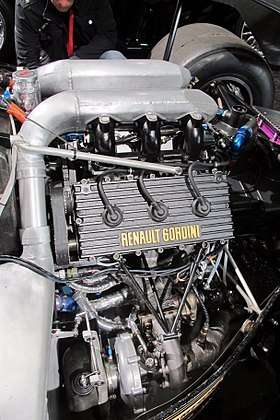Renault EF-Type engine
The EF-Type was a Turbocharged 90° V6 engine developed by Renault Sport, the engine was used by Equipe Renault Elf in Formula One from 1977 to 1985. This engine derived from the CH series designed by François Castaing, the F1 engine was developed by Bernard Dudot.
 | |
| Overview | |
| Manufacturer | Renault Sport |
| Production | 1977–1986 |
| Layout | |
| Configuration | 90° V-6 |
| Displacement | 1.5–1.5 L (1,492–1,494 cc) |
| Cylinder bore | 86 mm (3.39 in) 80.1 mm (3.15 in) |
| Piston stroke | 42.8 mm (1.69 in) 49.4 mm (1.94 in) |
| Compression ratio | 7.0:1-7.5:1 |
| Combustion | |
| Turbocharger | Garrett or KKK |
| Fuel system | Electronic fuel injection |
| Fuel type | Gasoline |
| Cooling system | Water-cooled |
| Output | |
| Power output | 510–1,200 bhp (380–895 kW; 517–1,217 PS) |
| Chronology | |
| Predecessor | CH |
Renault's decision to use its 1500 cc V6 turbo engines in F1 was one of the boldest decisions ever taken in the sport. In nine full seasons competing against normally aspirated 3000 cc engines, they gave an excellent account of themselves, with:
- One World Championship Runner-Up title in 1983.
- 20 race wins (15 with Renault, 5 with Lotus).
- 50 pole positions (32 with Renault, 18 with Lotus).
- 51 podium finishes (25 with Renault, 20 with Lotus, six with Ligier).
Ultimately, as a result of their success, all F1 teams adopted turbo engines in the 1985 season.
Engines
EF1
1977–1979
Based on the 2-litre "type CHS" engine and developing 510 bhp (380 kW; 517 PS) at 11,000 rpm, this engine underwent several major changes (metallurgy, mixed air-water exchanger) before bringing the Renault RS01 its first points in 1978 and its first pole position in 1979.
- EF1: 1.5 L (1,492 cc) Bore x Stroke 86 mm × 42.8 mm (3.39 in × 1.69 in) 7.0:1 Compression, one Garrett turbocharger.
1979–1983
With its two small turbochargers, this engine reduced turbo lag considerably. It brought Renault its first F1 race win with a turbo engine (Dijon 1979). It would undergo a number of significant changes over the years (electronic injection and two-flap air intake in 1982, water injection at air intake in 1983) and its horsepower would gradually increase, eventually reaching 700 bhp (522 kW; 710 PS). In all, it claimed 15 race wins, 30 pole positions and 19 pole positions and saw both Renault and Alain Prost finish second in the Constructors' and Drivers' Championships respectively. It was also supplied to the Lotus team in 1983.
- EF1: 1.5 L (1,492 cc) Bore x Stroke 86 mm × 42.8 mm (3.39 in × 1.69 in) 7.0:1 Compression, two KKK turbochargers.
EF4
1984
This engine marked the return of Garrett turbochargers. Fitted to the Renault RE50, Lotus 95T and Ligier JS23, it could not break the dominance of the Porsche built TAG V6 engine which powered the McLaren MP4/2 to 12 wins out of 16 races. It nevertheless notched up 11 podium finishes and three pole positions and allowed Lotus driver Elio de Angelis to finish the 1984 season in 3rd place. 1984 marked the first year since 1978 that a Renault engine did not win a Formula One race. By 1984, the Renault turbo was producing approximately 750 bhp (559 kW; 760 PS) in race trim and around 900 bhp (671 kW; 912 PS) for qualifying.
- EF4: 1.5 L (1,492 cc) Bore x Stroke 86 mm × 42.8 mm (3.39 in × 1.69 in) 7.0:1 Compression, two Garrett turbochargers.
It was the last engine to be badged "Renault Gordini", as there was now a new name to promote: Renault Sport.
"Type-Bis" early 1985
This engine's defining characteristics were its centralized electronic injection and ignition control systems. Generating just over 800 bhp (597 kW; 811 PS), it powered the Renault RE60, Lotus 97T, Ligier JS25 and Tyrrell 014. It was responsible for one race win, two pole positions and two podium finishes.
- EF4: 1.5 L (1,492 cc) Bore x Stroke 86 mm × 42.8 mm (3.39 in × 1.69 in) 7.0:1 Compression, two Garrett turbochargers.
EF15
mid-1985
With greater fuel economy thanks to its new dimensions and a lower boost pressure, its horsepower nevertheless oscillated between 800 bhp (597 kW; 811 PS) and 1,000 bhp (746 kW; 1,014 PS), thanks to metallurgical developments in the turbochargers. It earned two race wins and five pole positions for Lotus, as well as ten podium finishes (four for the Lotus 97T, four for the Ligier JS25 and two for the Renault RE60).
- EF15: 1.5 L (1,494 cc) Bore x Stroke 80.1 mm × 49.4 mm (3.15 in × 1.94 in) 7.5:1 Compression, two Garrett turbochargers.
"Type-B" early 1986
This engine boasted two innovative features that would soon gain widespread acceptance – static ignition and pneumatic valve actuation – which allowed it to reach 12,500 rpm. Capable of generating 900 bhp (671 kW; 912 PS) in race trim, it would record two race wins and five pole positions with Lotus, as well as five podium finishes (three with Lotus and two with Ligier). It powered the Lotus 98T and the Ligier JS27.
- EF15B: 1.5 L (1,494 cc) Bore x Stroke 80.1 mm × 49.4 mm (3.15 in × 1.94 in) 7.5:1 Compression, two Garrett turbochargers.
"Type-C" mid 1986
Equipped with a number of new features (cylinder heads, cylinder block, waste-gate, mapping, etc.) and developing more than 1,200 bhp (895 kW; 1,217 PS) at 12,500 rpm in qualifying, this engine enabled Ayrton Senna's Lotus 98T to notch up four pole positions and three podium finishes to close the V6 turbo era in style.